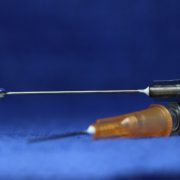Cortisone Shots for Knee Pain? Why You Should Think Twice.
Knee pain can be incredibly disruptive – turning simple, everyday activities like walking, climbing stairs, or even standing up from a chair into painful challenges. In search of quick relief, many people turn to cortisone shots. By targeting inflammation in the knee joint, cortisone injections can temporarily ease pain and swelling, making them an appealing option when you’re hurting.
But cortisone shots are just that – a temporary fix. And they come with significant risks and downsides that are often overlooked. Let’s take a closer look at why relying on cortisone injections may not be the best long-term solution for your knee pain – and what you can do instead to find natural, healthier, and lasting relief.
The Problems with Cortisone Shots:
1. Temporary Relief Without Addressing the Root Cause
Cortisone injections can offer pain relief that lasts for weeks or even months – but they don’t address the underlying issue of your knee pain. Instead, they mask your symptoms, allowing conditions like osteoarthritis, tendonitis, or mechanical imbalances to quietly worsen over time. By simply numbing your knee pain, cortisone shots act as a band-aid – covering up the real problem while harmful movement patterns and joint stress continue unchecked. This can eventually lead to more serious, long-term damage without you even realizing it.
2. Risk of Joint Damage
Since cortisone injections only offer short-term relief, many people end up getting them repeatedly. But over time, frequent cortisone shots can actually do more harm than good – leading to cartilage breakdown and weakening the tendons and ligaments around your knee. Research shows that repeated cortisone injections can accelerate joint deterioration, increasing your risk of needing knee replacement surgery down the line. This is especially concerning for active individuals who want to stay mobile, avoid major surgery, and protect their joint health for the long run. Many people aren’t aware of this – so it’s important to know the risks.
3. Disrupts Natural Healing
Inflammation, while painful and uncomfortable, is a vital part of your body’s natural healing process. It increases blood flow, delivers nutrients, and recruits immune cells to repair damaged tissue. Cortisone injections suppress this natural inflammatory response – easing pain and swelling temporarily, but at a cost. By interfering with inflammation, cortisone limits the delivery of key nutrients and healing cells needed to repair cartilage, tendons, or ligaments. Over time, this leaves your knee joint and surrounding tissues weakened, making full recovery harder to achieve. When knee inflammation does get out of control, it’s far better to choose natural healing accelerants that support your body’s repair process – rather than disrupt it.
4. Potential Side Effects and Complications
As with any injection or invasive procedure, cortisone shots come with potential risks, including infection. Other side effects can include increased blood sugar levels, skin thinning, and changes in pigmentation around the injection site. While these risks may seem minor, they deserve serious consideration – especially when the relief they offer is only temporary. Over time, repeated cortisone use increases the likelihood of experiencing these complications. It’s important to ask yourself if short-term relief is worth the growing list of potential long-term consequences.
What to Try Instead of Cortisone Injections:
When it comes to knee pain, I always advocate for natural and effective alternatives that not only alleviate discomfort but also promote true healing. Here are three proven methods that address the root cause of knee pain rather than just suppressing symptoms:
1. Regenerative Shockwave Therapy
Shockwave therapy is a non-invasive treatment that uses acoustic sound waves to stimulate the body’s natural healing processes. By creating micro-traumas in the affected tissues, shockwave therapy boosts blood flow and encourages tissue regeneration. This treatment has been shown to improve mobility, reduce pain, and help with conditions like calcific tendonitis and osteoarthritis. Unlike cortisone injections, which only mask symptoms and can contribute to tissue breakdown, shockwave therapy actively supports healing and long-term relief. When combined with EMTT (Electromagnetic Transduction Therapy), the effectiveness of shockwave therapy is further enhanced – EMTT penetrates deeper into tissues, increases cellular activity, and accelerates the healing process, giving you even faster and more lasting results.
2. Dry Needling for Muscle Imbalances
Dry needling is a highly effective technique for targeting muscle tightness and trigger points around your knee joint. By inserting thin needles into specific areas, this therapy helps release muscle tension, improve circulation, and restore proper function. Dry needling is particularly beneficial for individuals suffering from tendonitis, chronic stiffness, or muscular imbalances that contribute to knee pain. It encourages natural healing by allowing muscles to function more efficiently, reducing strain on your knee joint.
3. Working with a Mechanical Knee Pain Specialist
A mechanical knee pain specialist is trained to analyze movement patterns and pinpoint the underlying causes of your knee discomfort. Unlike general healthcare providers who may prescribe pain medications or generic exercises, these specialists take a customized approach – identifying joint misalignments, muscle imbalances, and faulty movement patterns to develop a personalized rehabilitation plan. They assess how the entire body contributes to knee mechanics, ensuring all contributing factors are addressed. This comprehensive, root-cause approach not only restores knee function and prevents future pain but also leads to more effective, lasting results compared to the temporary relief offered by cortisone shots.
A Smarter Path to Knee Pain Relief:
While cortisone shots may seem like a convenient and quick option, they do little to promote true healing of your knee pain and can actually cause long-term harm. Natural treatments – such as regenerative shockwave therapy, dry needling, and working with a mechanical knee pain specialist – offer a more effective and safer path to knee pain relief. Instead of masking pain, these alternative treatments address the root cause, restore function, and help prevent future injury – giving you real, lasting relief.




